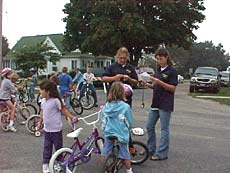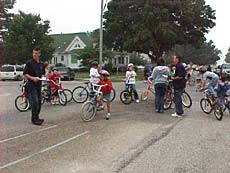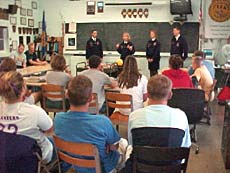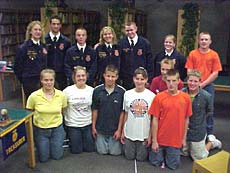|
Features,
Honors
& Awards, Ag
Announcements
Calendar,
Ag News Elsewhere
(fresh daily from the Web)
|
|
Features
|
|
Weekly outlook
Crop
forecasts
[OCT.
15, 2002]
URBANA — Based on harvest
reports to date, there is some expectation that both the corn and
soybean production forecasts will show modest increases in November,
said a University of Illinois Extension marketing specialist.
|
|
"The markets for corn and soybeans
should now turn more attention to the rate of consumption," said
Darrel Good. "With year-ending stocks of both crops expected to be
near minimum levels, the rate of consumption will have important
price implications.
"A consumption rate above that needed
to reach the projected level of use for the year would imply that
higher prices are needed to slow the rate of use. A slow rate of use
would imply a continuation of somewhat lower prices."
Good’s comments came as he reviewed the
USDA’s October Crop Production report, which contained small
surprises for both corn and soybeans. At 8.97 billion bushels, the
corn production forecast was 121 million bushels larger than the
September forecast and generally larger than expected. At 2.654
billion bushels, the soybean production forecast was unchanged from
the September forecast and generally smaller than expected.
The larger corn forecast reflects a
1.8-bushel increase in the projection of the U.S. average yield. At
127.2 bushels per acre, the forecast is 11 bushels below the 2001
average yield. The month-to-month increase resulted from a
10-bushel-per-acre increase in the projection of the Iowa average
and a seven-bushel-per-acre increase in the Minnesota projection.
Projections for Illinois and Indiana declined by two bushels, while
the projection for Ohio dropped by six bushels.

The U.S. average soybean yield is
projected at 37 bushels per acre, 2.6 bushels below the 2001
average.
"To date, the pattern of corn
production forecasts has followed the same pattern as that of last
year — lower in September and higher in October," Good said. "There
have been six years in recent history that have seen the same
pattern. In five of those years, the production forecast was larger
again in November. In one year, the forecast was unchanged in
November.
"The pattern of soybean production
forecast — higher in September and unchanged in October — has been
rare. It occurred in 1977, and in both 1973 and 1982 changes in the
forecast in October were small. In those three years, the November
forecast was higher once, unchanged once and lower once."
Good noted that while the history of
changes in production forecasts has some interest, it does not have
much predictive capability.
"Each year is unique," he said. "Based
on harvest reports to date, there is some expectation that both corn
and soybean production forecasts will show modest increases in
November."

For corn, there is general agreement
that domestic uses for seed, food and industrial purposes will
increase again this year. There is less consensus about domestic
feed and residual use and exports. The USDA projects a decline of
212 million bushels (3.6 percent) in feed and residual use during
the current year.
[to top of second column in
this article]
|

"Indications of only a modest reduction
in animal numbers and a projected 22 percent reduction in feed and
residual use of other feed grains suggests that consumption of corn
could be larger than projected," said Good. "In either case, the
reduction in use would not be expected until the last half of the
current marketing year. The first indication of the rate of domestic
feed and residual use will come with the December Grain Stocks
report, to be released on Jan. 10."
For exports, the USDA projects a
100-million-bushel (5 percent) increase during the current year.
Through the first five weeks of the year, shipments are running 37
percent below those of last year. In part, the decline reflects
interruptions in shipments at the Gulf and on the West Coast. Still,
total export commitments (shipments plus outstanding sales) are
running about 12 percent below the total of a year ago.
In the case of soybeans, the domestic
crush is expected to decline only 25 million bushels (1.5 bushels)
from the record crush of the past year.
"The major adjustment to the smaller
supply is expected to come in exports," said Good. "At 850 million
bushels, the USDA expects exports this year to be 21 percent smaller
than shipments of a year ago. The continued increase in South
American production is expected to fill the gap.
"To date, export shipments of soybeans
are down about 20 percent from the total of a year ago, while total
commitments are down about 7 percent."
The average cash price of corn in
central Illinois has declined to the lowest level since late July,
even though the basis has remained very strong.

"It is typically a weak basis at
harvest and a quick recovery in that basis that produces a
post-harvest recovery in cash prices," said Good. "The post-harvest
recovery could be small this year. If current production and
consumption forecasts are accurate, prices could languish in a
relatively narrow range through the winter and then become more
volatile in the spring."
Cash soybean prices in central Illinois
recovered slightly following the October Crop Production report, but
are at the lowest level since late June and are below the Commodity
Credit Corporation loan rate.
"In addition
to the rate of use, the soybean market will increasingly reflect the
development of the 2003 South American crop," said Good. "A larger
crop is already factored into the price structure, so that any
threat to the crops there would be expected to push prices higher."
[U
of I news release]
|
|
Want your ad to be
seen all over Logan County?
Advertise with
Lincoln Daily News!
Call (217)
732-7443
or e-mail
ads@lincolndailynews.com |
Our staff offers more than 25 years of experience in the
automotive industry.
Greyhound
Lube
At the corner of Woodlawn and Business 55
No Appointments
Necessary |
Lincolndailynews.com
is the place to
advertise
Call (217) 732-7443
or e-mail
ads@lincolndailynews.com |
|
|
|
It’s
time to talk bull
[OCT.
15, 2002]
URBANA — Now is the time
for purebred cattle breeders to begin identifying bulls they plan to
consign to the 2003 Illinois Performance Tested Bull Sale, said a
University of Illinois Extension animal systems educator. The sale
will be during the Winter Beef Expo on Feb. 20 at the Illinois State
Fairgrounds Livestock Center in Springfield.
|
|
"The sale accepts older as well as
yearling bulls, with the birth date limits from January 2001 to
March 2002," said Dave Siebert, who is based at Extension’s East
Peoria office. "The 2002 sale resulted in 104 bulls selling for an
average price of $1,797."
Seibert noted that the rules and
regulations for the 2003 sale will be almost identical to those used
in 2002. As was the case with the 2002 sale, there will be mandatory
Johne’s disease testing.
"However, brucellosis is the only other
disease that the animals will have to be tested for," he said.
Nomination deadline and fees are
three-tiered with the following dates and costs: Nov. 15, $75; Dec.
1, $100; and Dec. 15, $125.
For a
complete copy of the rules and regulations plus a nomination form,
contact Seibert at 727 Sabrina Drive, East Peoria, IL 61611; phone
(309) 694-7501.
[News release] |

 |
|
 |
|
|
Crop-pasture rotation, a biofuel crop
and consumer risk perceptions
Oct. 21 event provides info on three
research projects
[OCT.
15, 2002]
Researchers from the
University of Illinois will present information on three current
research projects being funded by the Dudley Smith Initiative.
|
|
When:
Monday, Oct. 21, from 9 a.m. to noon
Where:
Dudley Smith Farm, located off Route 29
between Taylorville and Pana
Subjects:
• "Integrating Livestock
into a Sustainable Cropping System" — A five-year project studying
extended pasture rotations with livestock integrated into
conservation-based row crop production.
• "Opportunities in Energy
and Agriculture" — This project is exploring elephant grass as a
biofuel in Illinois.
• "Risk, Consumer Behavior
and Agricultural Community Response" — Researchers will evaluate how
consumers assess risk associated with agricultural commodities and
production practices.
Details about the projects can be found
at
http://www.aces.uiuc.edu/DSI/current.html.
For more
information and detailed directions, please call (217) 287-7246.
[U of I news release] |

 |
|
|
 |
|
|
Hartsburg corn plot results
[OCT.
14, 2002]
Fall brings with it many
reports of yields, from both fields and plots. Many of these yields
should be used together to select hybrids or varieties. Of course
your personal experience should also play a key role in selections.
Some of the value-added crops need to be looked at as well.
|
|
The Hartsburg Field was a cooperating
site this year in one of the studies of value-added traits for corn.
The same varieties were planted in multiple locations and will have
statistics and economic data run on them at the University of
Illinois. Grain samples will also be tested for specific traits. See
the chart below for the unofficial,
unreplicated yield numbers from Hartsburg without the value-added
economics. You can check on contract premiums if you are interested
in these varieties.
|
Other research projects at
the Hartsburg Field have been harvested and sent to campus for yield
data and analysis. These include nitrogen application based on amino
sugar test and nitrogen and manure application rates. You will
probably see some of this data at the winter agronomy offerings from
around the state.
[John
Fulton]
|
|
|
Variety |
Trait |
Population |
Test weight |
Moisture |
Yield at 15% |
|
Adler 2650 |
Nutridense |
27000 |
60 |
16.3 |
131.15 |
|
Lewis 6002 |
Nutridense |
30000 |
58 |
16.2 |
132.47 |
|
Lewis 5072WX |
Waxy |
31000 |
60 |
15.8 |
172.80 |
|
Asgrow RX776 |
White |
26000 |
63 |
17.2 |
143.52 |
|
Burrus 582 |
Hard endosperm |
30000 |
59 |
14.5 |
158.87 |
|
QTI 4933 |
Hard endosperm |
31000 |
59 |
14.2 |
171.33 |
|
Wyffels W730 |
Hard endosperm |
31000 |
60 |
14.5 |
182.58 |
|
Adler 2700 |
High starch |
32000 |
57 |
13.0 |
159.25 |
|
QTI 4935 |
High starch |
30000 |
57 |
14.7 |
145.49 |
|
Wyffels 6570 |
High starch |
31000 |
57 |
14.0 |
151.45 |
|
Burrus 515P |
Conventional |
30000 |
58 |
12.4 |
157.92 |
|
Lewis 4830 |
Conventional |
29000 |
58 |
14.4 |
168.56 |
|
Golden Harvest H8906 |
Conventional |
30000 |
58 |
13.5 |
174.13 |
|
Pioneer 33P67 |
Conventional |
30000 |
60 |
15.9 |
197.09 |
|
|
|
It’s
almost time for
first fall frost in Illinois
[OCT. 12, 2002]
Leaves
just starting to show some color, chrysanthemums and asters in
bloom, the beginning of the harvest season, and cooler night
temperatures all signal fall’s arrival in Illinois.
|
|
"The first fall frost usually occurs
between Oct. 7 (northern Illinois), Oct. 14 (central Illinois) and
Oct. 21 (southern Illinois). The Chicago area can expect frost by
Oct. 14, a week later than the rest of northern Illinois, probably a
result of the warmer urban setting and the moderating influence of
Lake Michigan," says Jim Angel, state climatologist with the
Illinois State Water Survey, a
division of the Illinois Department of Natural Resources.
The average frost date is based on
1971-2000 averages. Although the actual date varies quite a bit from
year to year, "frost usually occurs within two weeks of these
dates," says Angel.
"Despite concerns about global warming,
the first fall frost date has been occurring a little earlier at
most Illinois locations since the early 1970s, suggesting somewhat
cooler fall conditions," says Angel.
[to top of second column in
this article] |
Data from 13 long-term cooperative
observer sites in more rural locations throughout Illinois indicate
that the frost date is 16 days earlier in McLeansboro; 14 days
earlier in Anna and Champaign-Urbana; nine days earlier in Hoopeston
and Windsor; seven days earlier in Sparta; and five days earlier in
Marengo, Walnut and Minonk. This pattern appears to be prevalent
across Illinois, except for a slight trend toward frost three days
later in Carlinville (west-central), one day later in Rushville
(northeast), and no change in Mount Carroll and Aledo.
"There’s a
good chance that Indian summer, a warm, dry spell after the first
fall frost, will occur this year. If so, more mild weather will
follow," concludes Angel.
[Illinois State Water Survey
press release] |
|
|
Fall fertilization programs
require careful preparations
[OCT.
12, 2002]
URBANA — As the fall
harvest is completed, Illinois growers will soon turn to
preparations for next year’s crop. And, according to Bob Hoeft, soil
fertility specialist with University of Illinois Extension, one of
the most important steps is to carefully prepare a fall
fertilization program.
|
|
"Fall application of phosphorus is an
acceptable practice on all but the sandy soils in Illinois," Hoeft
said. "On sandy soils, it would be best to wait until spring to
apply potassium. There is danger that fall-applied potassium
fertilizer might leach down far enough so as to not be readily
available for the newly planted crops next spring."
He notes that phosphorus can be applied
on all soil types in the fall, because it will not leach even in
sandy soils.
"Most of the phosphorus fertilizer used
in Illinois is an ammoniated form, which contains nitrogen," he
said. "This material nitrifies somewhat slower than most other
nitrogen fertilizers, and there is limited risk of fall-applied
ammoniated phosphate being lost in the spring. Those materials are
not volatile and do not need to be incorporated into the soil."
Although applied nitrogen is acceptable
in the northern two-thirds of the state, growers should use caution
to ensure that the fertilizer has the greatest potential to be
available for next year’s crop and the least potential to be lost to
the environment. Those cautions include using the proper rate,
applying it at the right time and selecting materials that are
effective for fall application.
"University research has shown that,
over the long term, the proper rate is 1.2 pounds of nitrogen per
bushel of corn that the field will be expected to yield," Hoeft
said. "This represents the total amount of nitrogen needed for that
field. It is important to also take into account the amount of
nitrogen that will come from legumes, manure and urea-ammonium
nitrate solutions that might be applied with pesticides. All of
those contributions should be subtracted from base rate."
Hoeft notes that the nitrogen rate can
be reduced by 40 pounds per acre for corn planted after soybeans. At
least 50 percent of nitrogen from manure will also be available for
next year’s crop. Worksheets for figuring the rate are available in
the Illinois Agronomy Handbook and online at
http://web.aces.uiuc.edu/aim/IAH/ch11/nitro.html.
[to top of second column in this
article] |
"The majority of nitrogen in
fertilizers sold in Illinois comes in the ammonium form," he said.
"As long as it remains in that form, it is not susceptible to loss,
even in the wettest conditions. Once it converts to nitrate,
however, it becomes susceptible to denitrification and leaching
losses when soils become excessively wet."
He points out that the conversion of
ammonium to nitrate can be slowed by cool soils and the use of a
nitrification inhibitor.
"Growers should not apply fall nitrogen
for corn south of Illinois Route 16," Hoeft said. "North of that
line, growers should wait until soil temperatures are less than 60
degrees Fahrenheit if a nitrification inhibitor is used or 50
degrees if no inhibitor is used. Irregardless of soil temperature,
application should not start until Oct. 15 in the northern three
tiers of counties and Oct. 21 between the third tier of counties and
Route 16."
He notes that anhydrous ammonia is the
most stable fertilizer for fall application because it is injected
in a concentrated band. Ammonium sulfate can also be applied in the
fall, but its application should be delayed until the soils are at
or near freezing.
"If
possible, growers should wait until late November or early December
before applying ammonium sulfate," Hoeft said. "Urea or
urea-containing products for corn should not be applied in the fall
or winter. The risk of loss from fall or winter applications is
substantial even when those materials are incorporated."
[U of I news release]
|
|
|
4-H takes over county windows
[OCT.
11, 2002]
Logan County 4-H clubs
recently participated in a window display contest throughout the
county as part of National 4-H Week activities.
|
|
Clubs that participated and display
sites were Atlanta Town and Country, using a window at the Atlanta
Museum Annex; Chester 4-H, at Abe Lincoln’s General Store in
Lincoln; Cloverdale, Lincoln Red Cross office; Clover Kids, Deron
Powell’s State Farm Insurance in Mount Pulaski; Hartem Clovers,
Hartsburg State Bank; Middletown 4-H’ers, Middletown Junior High;
Millennium Clovers, Heads R Turnin’ in Lincoln; and Wide-A-Wake 4-H,
Action Rentals in Lincoln.
|
First place went to the Wide-A-Wake 4-H
club for their window display at the Action Rentals store on
Broadway Street in Lincoln. Second place was awarded to Hartem
Clovers for their display at Hartsburg State Bank, and third place
went to Cloverdale for their display at Lincoln’s Red Cross office.
In addition, the 4-H clubs had a poster
contest. Katie Turner, a member of the Hartem Clovers, was chosen as
the winner.
For
additional information about the 4-H program in Logan County,
individuals can contact the Logan County Extension office at
732-8289.
[News
release] |
|
|
Agriculture + fun = FFA
[OCT.
9, 2002]
Section 14 officers, along
with Meagan Wells, the 2002-2003 Illinois FFA treasurer, conducted
visits Sept. 30-Oct. 4 to chapters throughout the section.
|
|
As the group traveled to 11 schools,
Meagan presented a program on the many opportunities available in
the FFA. The section officers helped out by sharing their own
experiences and informing the members about various conferences and
activities. After the program, FFA members filled out a goal card,
as Meagan challenged them to set their goals high and strive to
reach them.
A week of chapter visits would not be
complete without Leadership Training School. On Wednesday, Oct. 2,
all of the Greenhand FFA members and chapter officers came together
at Athens High School for a night of learning and fun. The group was
honored to have Mr. Dave Mouser, a motivational speaker and past
state officer, to kick off the night.
Then, the section officer team took the
respective chapter officers into a training session on their duties
as officers. Meagan Wells stayed with the Greenhand members for a
motivational session. As everyone came back together, the section
officer team had a little bit of fun distinguishing the differences
in proper and improper official dress. A meal was served, and then
Meagan Wells gave her keynote address.
The week of
activities filled with chapter visits and leadership training was a
great success. The officers wish all of the FFA members in Section
14 and across the state the best of luck in accomplishing their
goals this year and in the future.
[FFA news release] [to top of
second column in this section] |

[Photos provided by FFA]

[The Hartsburg-Emden
FFA helped the Logan County Sheriff's Department with a bike rodeo
at the Emden School. The Sheriff’s Department explained to the kids
about proper safety when riding a bike on the road.]

[The Hartsburg-Emden
chapter received a visit Monday from section officers and the FFA
state treasurer.]

[Hartsburg-Emden FFA
officers and Greenhands attended Leadership Training School at
Athens High School.] |
|
|
Honors
& Awards
|
|
|
Ag
Announcements
|
|